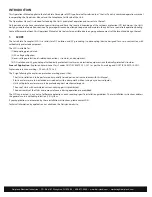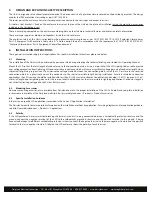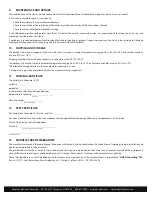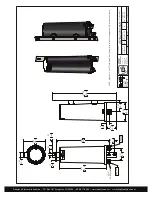
Dairyland Electrical Industries • P.O. Box 187 Stoughton, WI 53589 • 608-877-9900 • www.dairyland.com • [email protected]
7.
FIELD TESTING
WARNING:
Due to DC voltage and especially the possibility of AC induced voltage on cathodically protected structures, personnel may be exposed to unsafe
voltage. Measure for the presence of elevated voltage before contacting the structure. Sparking may occur when connecting or disconnecting
decoupling devices. Assure that this does not occur in explosion-prone areas. Take appropriate precautions to address voltage risks and arcing
exposure, as per industry practices and regulatory requirements.
Before installation, the following measurements are suggested to confirm that the steady-state conditions affecting the SSD are within its ratings.
1. Measure the open-circuit DC voltage between the SSD connection points with a multimeter. The open-circuit DC voltage measured should
be within the DC blocking voltage rating of the model selected (i.e. normally -3.0 V/+1.0 V or +/-2.0 V, unless a custom version has been
ordered).
2. Measure the steady-state short-circuit AC-RMS current between the SSD connection points with a clamp-on ammeter. The short-circuit
AC-RMS steady-state current measured should be less than the steady-state AC current rating of the SSD model ordered.
3. After installation, the DC voltage across the SSD terminals can be measured to confirm that the expected value of cathodic protection (CP)
voltage exists, assuming the cathodic protection system is ON. The voltage measured with a voltmeter will be less than the actual cathodic
protection (CP) voltage because it is not being measured with respect to a reference cell.
4. After installation, the steady-state AC current through the SSD conductors can again be measured. The current measured should be
comparable to the value measured prior to installation since the AC impedance of the SSD is negligible (e.g. about 10 milliohms at 60 Hz)
5. To verify the correct device operation while in service, measure the pipe to soil voltage using a reference cell. An acceptable CP reading
will indirectly indicate the correct operation with DC isolation, as device conduction would connect the CP system to the ground (or to
the other connected structure) and affect the CP reading. While it is an indirect test, it has proven to be a good indicator of operation. An
unacceptable reading may be due to other factors besides the Dairyland Unit, and if needed, perform further additional tests.
6. The definitive test is performed with the device out of circuit. If the device is in service, disconnect the CP structure attachment conductor
(typically at the negative terminal) so that the product is isolated, but first addressing any safety issues such as adding a current-rated
bonding jumper between the two connection points, wearing insulating gloves, etc. Note that if the Dairyland Unit is performing
mitigation of induced AC voltage, disconnecting the device will make the structure an open circuit, and the induced voltage on the
pipeline may rise to high levels. Therefore, take appropriate safety measures before proceeding. Next, briefly short the device terminals
to remove any residual charge that may exist on the internal capacitor. Connect a multimeter, set to the lowest Ohms scale, across the
terminals. If the product is functional, the resistance will start at zero ohms and then increase very slowly as the capacitor in the decoupler
begins to charge from the multimeter. The test may be stopped at this point, as charging the capacitor can take up to 10 minutes, and
it is only necessary to observe this general response briefly. If the product is out of order, the reading will remain fixed and at a very low
resistance value, typically a fraction of one Ohm.
If no measurements produce the expected results, please contact Dairyland.
8.
OPERATION SAFETY REQUIREMENTS
The device shall be placed into service in accordance with the ratings and limitations stated in the installation and operating instructions.
WARNING:
Potential electrostatic charging hazard – Plastic enclosures are to be cleaned or wiped with a damp cloth only.
Units must be protected against mechanical impacts.
The operation of Units with uninsulated current-carrying parts and damaged isolation is prohibited.
The disassembly of the Units and removal of covers during operation are prohibited.
8.1
During Unit preparation and operation thereof
the following safety precautions must be observed.
In the course of the Unit maintenance it is prohibited to:
- Inspect and repair any internal parts while the Unit is in operation.
- Touch any terminals or uninsulated current-carrying conductors.
- Switch the Unit ON without prior careful inspection and testing of all elements if it was switched OFF due to any defect.
- Work with an ungrounded Unit.
- Operate the Unit having the electrical isolation resistance below the limit permitted under the policies of electric equipment operation
applicable at the site.
- Switch ON and operate any defective Unit.






































